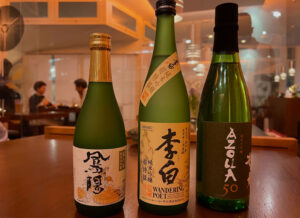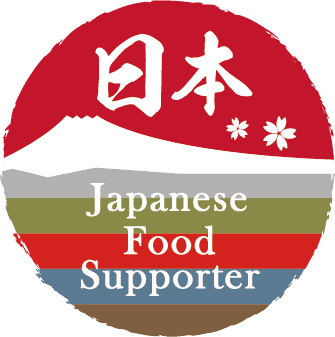What does Washoku mean?
In short Washoku a generic term, which from the field of Japanese cuisine both some Foodas well as certain typical local Ingredients and Preparation methods includes.
Also philosophical elements that can be found in the Sideboards and Present express belong to Washoku.
Washoku is closely with the culture, the special Regionality and Seasonality of the Japanese archipelago.
What is the meaning of the word Washoku?
The little word "Wa" (和) stands for harmony, an essential key element in Japanese culture.
This word is used in various combinations to refer to something Japanese. When it is used here with the kanji shoku (食) to mean food, it indicates that it is japanese Food in contrast to western Food (Yōshoku, 洋食) acts.
Thus, one could say that the word Washoku is either associated with "The cuisine of Japan" - or also with "A kitchen of harmony" or "A cuisine of balance" can be translated.
Connection of word and content at Washoku
And in fact, balance is a central component in Japanese cuisine: a balance
- of the ingredients,
- of the taste sensations,
- of the preparation methods,
- of the optical balance.
Meeting and mastering all these requirements, while combining them with seasonal and regional characteristics, makes Washoku, the cuisine of Japan, a true art and a special cultural heritage.
At the same time, the typical Japanese taste of central dishes and traditional cooking methods is closely with regional, natural ingredients around the Japanese island kingdom interwoven.
In a cuisine based on the principles of Washoku, rice, fish and seasonal vegetables are the main ingredients used. Meat is not taboo, but only in a balanced proportion with other ingredients.
Seasoning is usually moderate with products such as Soy sauce or miso paste, which bring their own qualities through a very special fermentation process that is also typically Japanese.
Washoku is therefore an umbrella term for certain styles of cuisine, also for certain philosophies, for certain cooking methods and also for certain typical ingredients around Japan. Washoku is, so to speak, its own culinary world.
All the kitchen's efforts to not only recreate a Japanese recipe, but to properly prepare ingredients and produce good cuisine in the sense of washoku, in our experience, leads people who enjoy this form of authentic Japanese cuisine to become imperceptibly satisfied. Those who are experienced in Japanese cuisine may even feel a great sense of happiness at the first bite, not only because they are hungry and get something to eat, but because the typical, subtle and harmonious flavors spread, a feeling of (palate) pleasure arises.
Different styles of cuisine are part of Washoku
Basically, quite different styles of cuisine can be found under the term Washoku.
There is the "home cooking" (Katei Ryōri 家庭料理), so to speak the "daily bread" of the Japanese.
But there are categories that can not be cooked at home, but require specialized chefs or appropriate experience.
These certainly include Kaiseki, welches zwei gleich ausgesprochene, aber unterschiedlich geschriebene und inhaltlich verschiedene Traditionen beinhaltet:
das Cha-Kaiseki aus der Teezeremonie (茶懐石 oder 懐石) und das culinary kaiseki (会席) as artful seasonal and regional cuisine at the highest level.
Aber auch Shōjin-Ryōri (精進料理), die vegetarische Küche der Zen Mönche gehört dazu.
Washoku is also typically expressed, for example, in lunch boxes called Bentō: these are containers of different sizes, shapes and materials in which typical Japanese food is arranged according to very specific basic principles. Bentō is a wonderful world that is also gaining more and more fans in Germany.
Und natürlich kennt heute alle Welt Sushi – Sushi ist aber nur ein ganz kleiner Teil der japanischen Küche, ein extrem anspruchsvolles Spezialgebiet zwar, aber dennoch bietet die japanische Küche weit mehr als nur Sushi. Sashimi, roher Fisch ohne Reis, der oft in einem Atemzug mit Sushi auftaucht, ist dagegen aber seinerseits ein unverzichtbarer Teil übergreifender japanischer Küchenstile wie von Kaiseki.
What are basic principles of Washoku
A kitchen that is committed to the idea of Washoku should, above all, bring out the following core aspects:
- The flavors of Japan's diverse habitats (for example, coastal regions, mountainous regions, rural regions) and their respective foods are represented and brought out through appropriate techniques.
- It is set to balanced food ingredients paid attention to, which leads to a healthy diet.
- The beauty of nature and the change of Seasons are expressed through a skillful, appropriate presentation.
- Traditional, cultural events have their significance for the entire population and are also reflected in corresponding dishes, which are typical for the respective time in the course of the year.
- There are several variations of the Menu structure according to the principle of Ichijusai, "one soup, three dishes".
Typical Japanese: everything regulated
Washoku includes an extensive set of rules that has evolved over the centuries and still applies today.
Whether it is the daily Lunchbox for the schoolchildren or an exquisite kaiseki, rules are always observed, compliance with which in any case results in a balanced meal at the end. And because Japanese often unconsciously experience and adhere to these rules from an early age, things like obesity were virtually unknown for a long time and really only came about when more and more Western food was served in Japan.
It was probably not for nothing that it was a Japanese, Ikeda Kikunae (池田菊苗), who came up with the now globally recognized fifth taste, umami (旨味, translated roughly as "full-bodiedness").
Washoku means seasonality
Washoku, however, also stands for seasonality and centuries of tradition in particular, with seasonality even extending to the tableware used.
Washoku combines different ingredients and preparation methods always with a focus on giving each ingredient its own stage and showing the best. The eye eats along and all senses are challenged.
Washoku means high quality, healthy ingredients
However, health also plays an important role. Not for nothing you can find in Washoku a lot of fermented food like Soy sauce, miso and much more.
Fat plays a rather small role and if so, then mostly in fried foods like tempura - and actually tempura was first brought to the country by the Portuguese.
Due to Japan's island location, many ingredients naturally come from the sea. Dashi, the ubiquitous broth, also consists mostly of kombu, seaweed from the sea.
Typische Toppings, Saucen und Würzmittel
Den japanischen Geschmack in Worte zu fassen, ist manchmal nicht leicht.
Leichter verständlich sind jedoch isolierte und typische, oft auch im Westen inzwischen gut bekannte Grundzutaten und Würzmittel: Sojasauce, Yuzukosho, Mirin und so weiter. Hier ein Überblick über die Chōmiryō der japanischen Küche,
Regionality as the origin of Japanese taste
Of course, regionality is first and foremost evident in the use of ingredients. For example, certain types of vegetables exist only in Kyōto and are grouped under the generic term Kyō-yasai. The city of Kyōto has specially created a list of the so-called Kyo-no-Shunyasai, which contains about 40 types of vegetables. Among the best known are kamo nasu (eggplant), kintoki ninijin (carrot) and shogoin kabu (turnip). The latter is almost exclusively processed into tsukemono.
In addition to Kyō-Ryōri (Kyōto), the best-known regional cuisines include the cuisine from Kanto, i.e. the area in and around Tōkyō, and that from Kansai (i.e. the region around Ōsaka).
Aber auch der grundsätzliche Geschmack der japanischen Küche hat einen direkten Bezug zum japanischen Archipel: eine Grundzutat vieler japanischer Speisen „Dashi“.
Dashi wird gewonnen aus der Konbu-Alge, welche überwiegend an der Nordküste Japans vorkommen, und von gehobelten Thunfischspänen, Katsuobushi, der gerne in den südlichen Gewässern Japans gefischt wird. Zwar kommen Thunfisch und Algen auch in anderen Teilen der Welt vor.
But the central link of the dashi fund present in many places of Japanese cuisine with the direct regionality of the island kingdom of Japan is indeed a peculiarity.
And incidentally shows that in Japan, except for special cuisines such as the food of Buddhist monks, there is not so much distinction between vegetarian and non-vegetarian.
Regionally different interpretations of the dishes
But other regions also have very different interpretations of the same dish.
For example, a typical Japanese dish with strong regional characteristics is "Zōni" (雑煮) or "Ozōni" (お雑煮), which is eaten at New Year.
It's basically a soup with mochi and other ingredients (vegetables and meat).
Depending on the region, the soup may be "oaumashi" (お清まし, clear soup), or it may contain miso, or azuki beans may be added. Also, depending on the region, mochi can be round or square. The other ingredients also vary.
All variations, however, are ultimately the New Year's dish called "Zōni" (or Ozōni with the honorific syllable O in front). And of course in Japan there are even Websites that collect and list Ozōni regional diversities..
Importance of presentation and tableware
But a very special role in Washoku also plays the presentation, from the plate itself to the arrangement of the respective dishes on the plate.
Ähnlich wie Saisonalität bei Zutaten, gibt es auch eine Form der Saisonalität bei den Gefäßen. Ein rauher Keramikteller vermittelt winterliche Wärme, eine feine Lackschale mit einer leichten Misosuppe vermittelt angenehme Kühle durch ein paar wie zufällig auf den Deckel gesprenkelte Wassertropfen. Und natürlich ist gerade auch im Kaiseki die Präsentation der Speisen und die Auswahl des Geschirr in höchster Form zu finden.
Again and again the number five
In all cases, elements play a role here, which are always referred to. The following list only touches a few terms, in fact this system is of course very profound and can be explained arbitrarily deep.
Five colors (五色 go-shiki)
- White → Metal: Rice, Tofu etc.
- Yellow → Earth: pumpkin takuan (fermented radish colored with kuchinashi) etc.
- Green → wood: green vegetables, oily fish like mackerel etc.
- Black → water: black soybean, shiitake etc.
- Red → fire: shiso, tuna etc.
Five flavors (五味 go-mi)
- Sour (酸san)
- bitter (苦ku)
- sharp (辛shin)
- Salty (鹹kan)
- Sweet (甘kan)
Five preparations (五法 go-hō)
There are five classic preparation methods in Japanese cuisine. Make sure that in a large meal, for example a Kaiseki menuall these types of preparation should be represented.
- Raw (生 nama)
- Simmern (煮る niru)
- Barbecue (焼く yaku)
- Frying (揚げる ageru)
- Steaming (蒸す musu)
Five senses (五感 go-kan)
Seeing (視覚, Shikaku)
Taste (味覚、Mikaku)
Smell (臭覚, Shūkaku)
Listening (聴, Chōkaku)
Feel (触覚, Shokkaku)
Preparation and dressing
Washoku also has a very special approach to preparation: Not only the cooking process brings out the flavor of each ingredient, but quite significantly the cutting of the ingredients. Thus, there are not only numerous different types and shapes but even own names for all these different cutting types.
Taste by cutting in Japanese cuisine
Where in Western cuisine the flavor of a dish is often defined by seasoning, boiling, frying, etc., in traditional Japanese cuisine the goal is to very carefully bring out the natural flavors of the ingredients from the raw material and to emphasize or refine them. This is how Japanese cuisine creates the Taste often due to cuttingThis, of course, requires a great deal of experience and knowledge of the respective cutting techniques, which can differ from fish to fish.
In 2018, we have a published a small series about Japanese knives and cutting techniqueswhich is still worth a look today. Soon we will complete and expand the series.
Likewise, fat and oil are usually used very sparingly, for example, when frying tempura. Cooking, steaming, etc. are always designed not to completely mask the original flavor, but only to harmonize it.
Moritsuke - the doctrine of the presentation of Japanese food
But the presentation of the finished food also plays a major role in Japan. Apart from the Bentō, where everything should be packed so that nothing shifts even during transport, the empty space on the plate plays a major role, combined with an intentional the asymmetry that can come to light in this space.
Both are, after all, components of WabiSabi (侘寂), the perception of beauty and Japanese aesthetics. The multi-layered rules for arranging and presenting are summarized under the umbrella term Moritsuke.
Even though it seems extremely complicated to the outsider, most Japanese have no problem following the rules because they grow up with it, see it everywhere every day, and it seems so perfectly natural to them.
Kansha - the appreciation of the gifts of nature
Last but not least, kansha is an important part of washoku: appreciation for nature's gifts, recognition for the effort and ingenuity that goes into preparing them, and last but not least, avoiding waste. For example, one can peel a radish and then cut the peels into fine strips and dry them. Then later you can use these dried radish strips to make a tasty broth.
Furthermore, it is about the economical use of resources, also with regard to energy.
Washoku - a Japanese cuisine of harmony and depth
All these aspects certainly contribute to the fact that Washoku is perceived as very complex on the one hand and very clear at the same time.
While most Japanese grow up with it and thus perceive this cuisine as uncomplicated and natural, Washoku often seems unfamiliar and almost alienating to foreigners in all its depth and range.
Most cuisines in the world use more spices, and so one may first have to "learn" to perceive and enjoy the many natural nuances of Washoku. In fact, spices are used only in isolated places in Japanese cuisine; the flavor of the natural applies, brought out in an artful and balanced way and only accented or contrasted by individual, selective seasonings. As Japan is often called the culture of silence, Washoku is indeed also a cuisine of authenticity of taste and dignity of ingredients.
So it is often not surprising that abroad often only a copy or a superficial copy of the Japanese cuisine is offered.
Because the preparation methods to achieve the Japanese taste are complex, require a lot of preparations.
People who did not grow up with these tastes often have a hard time perceiving the subtle flavors of Japanese cuisine and thus distinguishing true Japanese cuisine from pan-Asian mishmash.
So, when visiting a Japanese restaurant in Germany, pay close attention to whether it is an authentic Japanese restaurant in order to approach this healthy, pleasure-giving universe of flavors.
A few hints on how to distinguish a real Japanese restaurant from a pseudo-Japanese one can be found in the article recognize japanese restaurants abroad.






